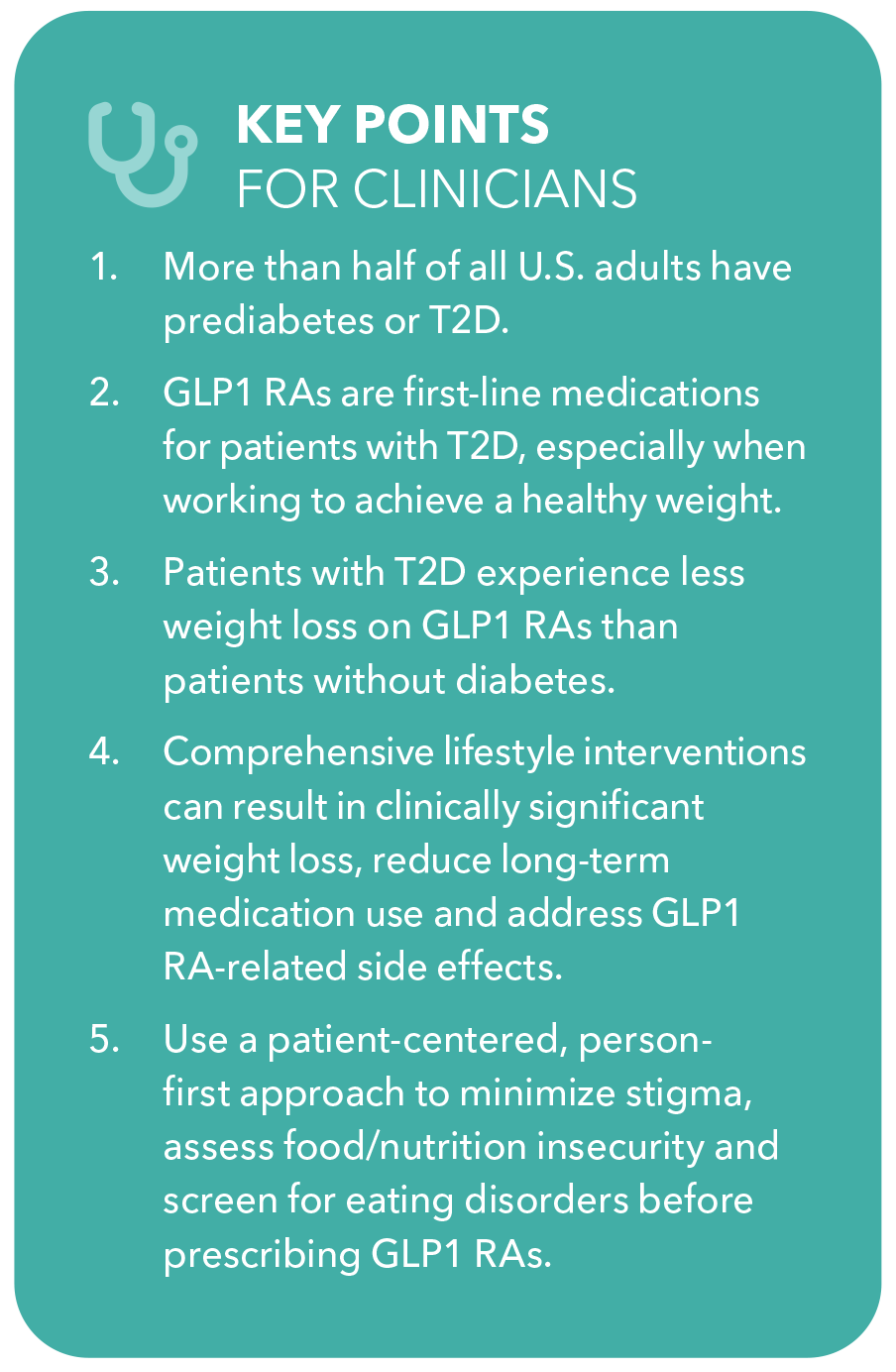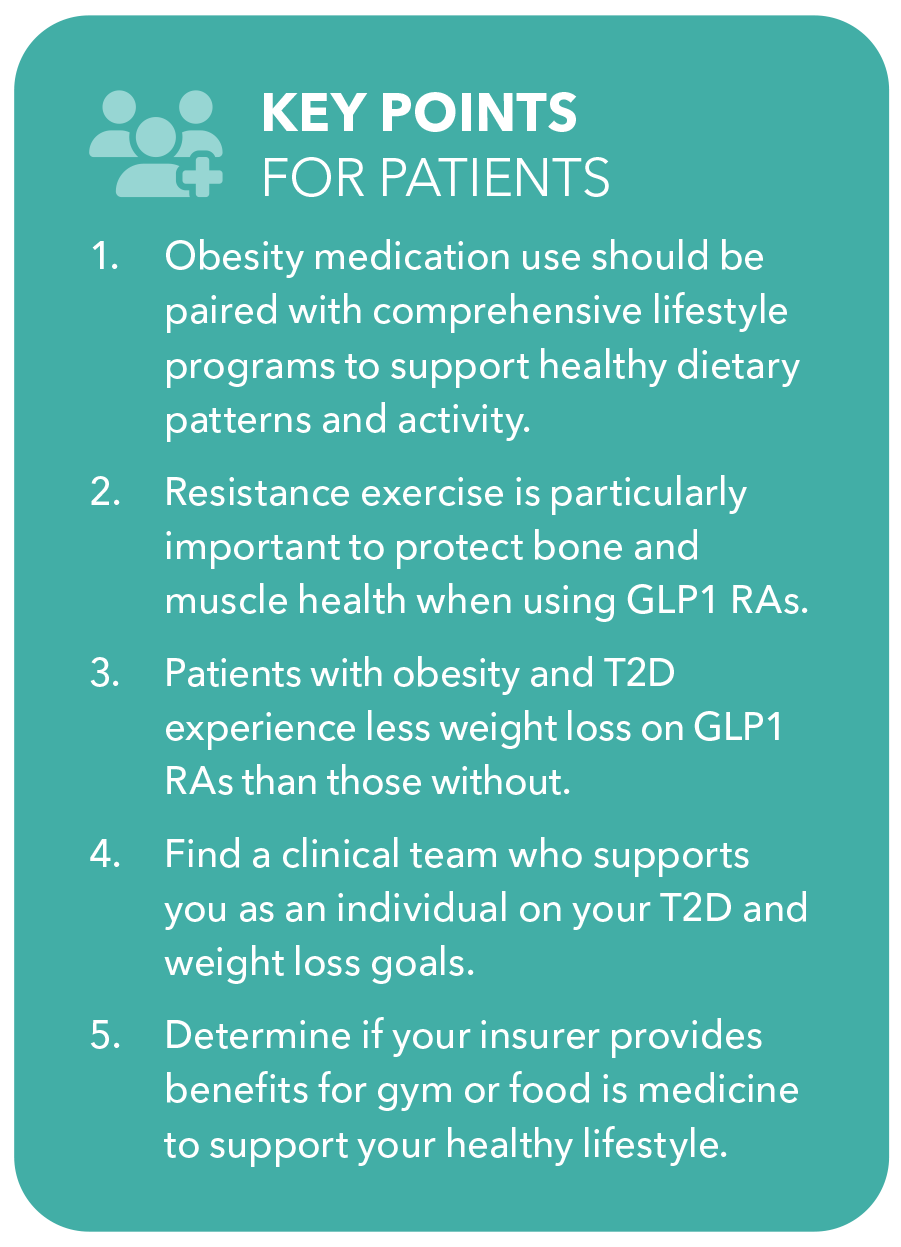Prioritizing Health | Diabetes, Diet and GLP-1 RAs

In 2021, the prevalence of type 2 diabetes (T2D) climbed to an estimated 38.4 million adults (nearly 15% of U.S. adults).1 When combined with the 97.6 million U.S. adults with prediabetes, over half of U.S. adults (52%) are affected by either prediabetes or T2D.1
The standards for diabetes management from the American Diabetes Association (ADA) have evolved significantly in recent years, and their 2025 standards recommend SGLT2 inhibitors and GLP1 RAs as first-line, glucose-lowering medications for all patients with diabetes.2 Moreover, the recommendation highlights the use of GLP1 RAs for the primary goal of achieving a healthy weight for patients with T2D.2 Given that achieving a healthy weight can prevent the progression from prediabetes to T2D and result in T2D remission with just a 10-15% total body weight loss, it is unsurprising that use of GLP1 RAs has surged, with 12% of all U.S. adults and 43% of those with T2D reporting GLP1 RA use.3,4
Physiologically, intestinal cells respond to digested nutrients by secreting GLP1 into the blood and directly triggering nerves that go to the brain regions that control energy intake and reward.5,6 Nutrients associated with GLP1 secretion are monosaccharides, long-chain fatty acids and short-chain fatty acids (from bacterial fiber fermentation).6,7 Semaglutide (GLP1 RA) and tirzepatide (dual glucose-dependent insulinotropic polypeptide (GIP)/GLP1 RA) are the most potent nutrient-stimulated incretin hormone-based therapeutics on the market.

Among patients with T2D, semaglutide and tirzepatide result in placebo-adjusted 6.2% and 11.6% average total body weight reduction at one year.4 Placebo-adjusted weight reduction is even greater for patients without diabetes: 12.4% for semaglutide and 17.8% for tirzepatide.8 Reasons for less weight loss with GLP1 RAs for T2D could include use of insulin or other obesity-promoting medications, concerns over hypoglycemia, decreased glycosuria, microbiome variation, genetic predisposition towards weight gain, and differences in endogenous GLP-1 pathways in the brain and other tissues.7,9
Although GLP1 RA-based therapies can play an important role in T2D and weight management, they should not be prescribed without a comprehensive lifestyle intervention. Such interventions are key for supporting overall health, and even without GLP1 RA use resulted in sustained ≥10% weight loss for nearly 30% of patients with T2D at eight years.10
Additionally, GLP1 RA use has notable challenges: frequent gastrointestinal side effects, risk for nutritional deficiencies, muscle and bone loss, high costs and limited accessibility. These factors contribute to the over 35% of patients with T2D who discontinue GLP1 RA use at one year.
Thus, comprehensive lifestyle interventions focused on nutrition for weight and side effect management, resistance exercise to maintain bone and muscle health and sleep/stress management may address some of the challenges with GLP1 RA use. Lifestyle interventions may sustain weight maintenance and metabolic health after GLP1 RA discontinuation.11,12 Importantly, these structured lifestyle interventions may support more effective use of these medications due to their high costs, which are a large and rising contributor to the more than $400 billion in annual U.S. health care spending for patients with T2D.4,13

When discussing weight and lifestyle change, it is important to take a patient-centered approach. This includes taking care to minimize weight stigma, which can damage the patient-clinician relationship, result in delayed or canceled care and lower treatment efficacy.14,15 It is helpful to first ask permission to discuss weight, review past experiences with weight management, and use person-first language to emphasize that people are not defined by their condition (e.g., a patient has or lives with diabetes or obesity, rather than a diabetic or obese patient).14,15 Screening for eating disorders should also be completed before prescribing GLP1 RAs, with referral of patients to a specialist as appropriate.16,17
A spectrum of healthy dietary patterns is recommended for patients with diabetes using GLP1s. While these include low-fat vegan/vegetarian, low-carbohydrate and Mediterranean dietary patterns,4,8 they share a common foundation of minimally processed, fiber and nutrient rich foods like fruits, vegetables, legumes, nuts, seeds, plant oils, dairy and seafood, with eggs and poultry in moderation; and avoiding ultraprocessed and restaurant foods high in refined starch, sugar, salt and additives.
While additional research is needed to identify specific dietary patterns that maximize treatment efficacy, a patient-centered approach should take into account the individual's food and cultural preferences, socioeconomic barriers to healthy food access and diet quality.4,17,18 Based on the importance and complexities of managing dietary patterns for patients with T2D and GLP1 RA use, health insurance coverage of evidence-based, clinically indicated Food is Medicine therapies is critical to ensure all patients have equitable access to a health-promoting dietary pattern to manage their disease in conjunction with GLP1 RAs and related therapies.17,19,20
This article was authored by Ryan M. Kane, MD, MPH, at Duke University School of Medicine and Dariush Mozaffarian, MD, DrPH, FACC, at Tufts University and Tufts Medical Center.
References
- Centers for Disease Control and Prevention. National Diabetes Statistics Report. May 15, 2024. Access here. https://www.cdc.gov/diabetes/php/data-research/index.html
- Committee ADAPP. 9. Pharmacologic Approaches to glycemic treatment: standards of care in diabetes—2025. Diabetes Care 2024;48(Supplement_1):S181-S206.
- Montero A, Sparks G, Presiado M, Hamel L. KFF Health Tracking Poll May 2024: The Public's Use and Views of GLP-1 Drugs. KFF. Updated May 10, 2024. Accessed April 14, 2025. Access here. https://www.kff.org/health-costs/poll-finding/kff-health-tracking-poll-may-2024-the-publics-use-and-views-of-glp-1-drugs/
- Committee ADAPP. 8. Obesity and Weight Management for the Prevention and Treatment of Type 2 Diabetes: Standards of Care in Diabetes–2025. Diabetes Care 2024;48(Supplement_1):S167-S180.
- Morton GJ, Meek TH, Schwartz MW. Neurobiology of food intake in health and disease. Nat Rev Neurosci Jun 2014;15(6):367-78.
- Bodnaruc AM, Prud'homme D, Blanchet R, Giroux I. Nutritional modulation of endogenous glucagon-like peptide-1 secretion: a review. Nutrition & Metabolism 2016;13:92.
- Huber H, Schieren A, Holst JJ, Simon M-C. Dietary impact on fasting and stimulated GLP-1 secretion in different metabolic conditions – a narrative review. Am J Clin Nutr 2024;119:599-627. doi:https://doi.org/10.1016/j.ajcnut.2024.01.007.
- Elmaleh-Sachs A, Schwartz JL, Bramante CT, et al. Obesity management in adults: a review. JAMA 2023;330:2000-15.
- Jensterle M, Rizzo M, Haluzík M, Janež A. Efficacy of GLP-1 RA approved for weight management in patients with or without diabetes: a narrative review. Adv Ther 2022;39:2452-67.
- Look AHEAD Research Group. Eight-year weight losses with an intensive lifestyle intervention: the look AHEAD study. Obesity (Silver Spring) 2014;22:5-13.
- Jensen SBK, Blond MB, Sandsdal RM, et al. Healthy weight loss maintenance with exercise, GLP-1 receptor agonist, or both combined followed by one year without treatment: a post-treatment analysis of a randomised placebo-controlled trial. eClinicalMedicine 2024;69:doi:10.1016/j.eclinm.2024.102475.
- Jensen SBK, Sørensen V, Sandsdal RM, et al. Bone health after exercise alone, glp-1 receptor agonist treatment, or combination treatment: a secondary analysis of a randomized clinical trial. JAMA Network Open 2024;7:e2416775-e2416775.
- Parker ED, Lin J, Mahoney T, et al. Economic costs of diabetes in the U.S. in 2022. Diabetes Care 2024;47:26-43.
- Kane RM, Williams SB, Reynolds K, et al. Patient perceived weight stigma and patient-centered language use preferences: A cross-sectional mixed methods analysis conducted in a large academic medical center. PLOS ONE 2025;20:e0314269.
- Albury C, Strain WD, Brocq SL, et al. The importance of language in engagement between health-care professionals and people living with obesity: a joint consensus statement. Lancet Diabetes Endocrinol 2020;8:447-55.
- Aoun L, Almardini S, Saliba F, et al. GLP-1 receptor agonists: A novel pharmacotherapy for binge eating (Binge eating disorder and bulimia nervosa)? A systematic review. J Clin Transl Endocrinol 2024;35:100333.
- Almandoz JP, Wadden TA, Tewksbury C, et al. Nutritional considerations with antiobesity medications. Obesity 2024;32:1613-31.
- Berkowitz SA, Seligman HK, Mozaffarian D. A new approach to guide research and policy at the intersection of income, food, nutrition, and health. Health Affairs 2025;44:384-390.
- Mozaffarian D, Aspry KE, Garfield K, et al. "Food Is Medicine" strategies for nutrition security and cardiometabolic health equity: JACC State-of-the-Art Review. J Am Coll Cardiol 2024;83:843-64.
- Garfield K, Hanson E, Shachar C, Stain P, Mozaffarian D. States' use of Medicaid managed care 'In lieu of services' authority to address poor nutrition. Health Affairs 2025;44:422-28.
Clinical Topics: Prevention, Diet
Keywords: Cardiology Magazine, ACC Publications, Semaglutide, Sodium-Glucose Transporter 2 Inhibitors, Glucagon-Like Peptide 1, Diabetes Mellitus, Type 2, Diet
